Microphone measurement and sound check
First of all, we can also measure the frequency range of the microphone to accommodate the feedback of the readers. For this we use our measuring room again, but we virtually reverse the process. Of course, a true reciprocity calibration as a starting point exceeds our current possibilities and the effort far exceeds the benefits. That is why we have sought a compromise.
However, since we have a calibrated measuring microphone, a comparison measurement and the calculation of the differences can at least produce a curve that is easily usable for our purpose. So it is not the exact frequency response of the microphone, we would not presume that, but a meaningful approximation, which also underpins our subjective impression.
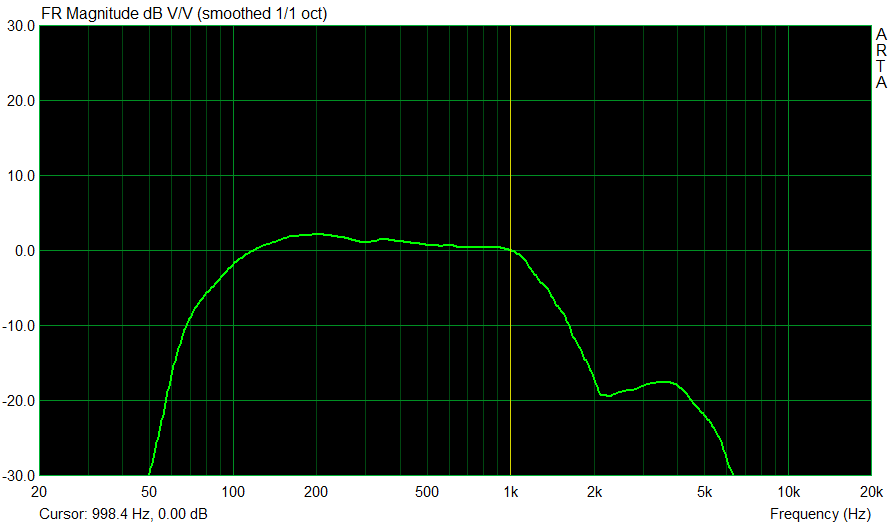
Measuring and audible you can see that there is a real low-cut and the course of the measuring curve drops steeply downwards below 100 Hz. The specified 50 Hz is in fact never reached, but that doesn't have to be either. But you can also record the same extreme drop above a kilohertz and that's exactly what makes the microphone sound musty, dull and far too bass-heavy. Sibilants are hardly reproduced any more and the removal of the pop protection only marginally relieves all this.
Headphone measurement
As we test, we have already explained in the basic article "Gaming Headsets: Myth, Truth and How we Test" very detailed and transparent, because with the usual audio-swirl of bass thunderstorms and high-pitched whips you can't really get any further. You have to be able to listen subjectively well and measure at the same time. Let us start with the latter.
Let's move on to measuring the quality of the headphones. I have again normalized the frequency curve at 1 KHz to 0 dB, so that on the one hand one can evaluate the overall course with all encores and frequency waste and on the other hand not completely loses the possibility of comparison to previous measurements. But it is still different, because the smoothing (1/1 octave) is supplemented by the almost unsmoothed representation (1/24 octave). Of course, all of this looks much more "hilarious", but also fits much better with reality. Because one thing is also clear: it does not exist, the ideal curve.
But let's start with the smoothed curve, because it's easier to explain. What we see is a typical bathtub with weaknesses in the upper middle and up to approx. 5 KHz. The bass is there, but very porous and at 70 to 100 Hz abundantly overemphasized, which also suggests resonances. By the way, this does not meet the level and the sound pressure. The increase between approx. seven and 11 KHz comes far too late.
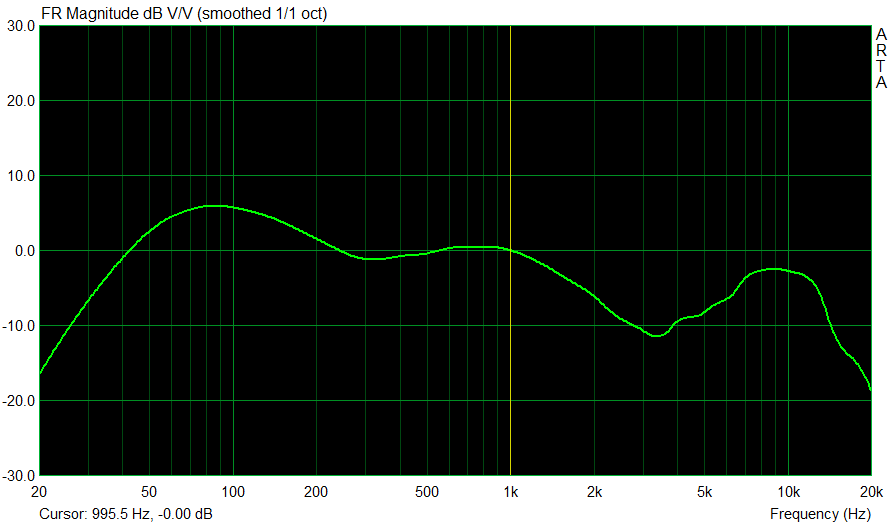
Now let's put aside the PR-compatible display and look at the unsmoothed curve. Of course, the "only" semi-professional measuring equipment also plays a role here, but nevertheless the measured is very similar here as well. We can see here once more clearly that the bass tuning in the peak at approx. 72 Hz. This is certainly a compromise between draught, level strength and the active inclusion of the earcup as a resonant body. However, something like this also screams for damping material inside, which is completely missing.
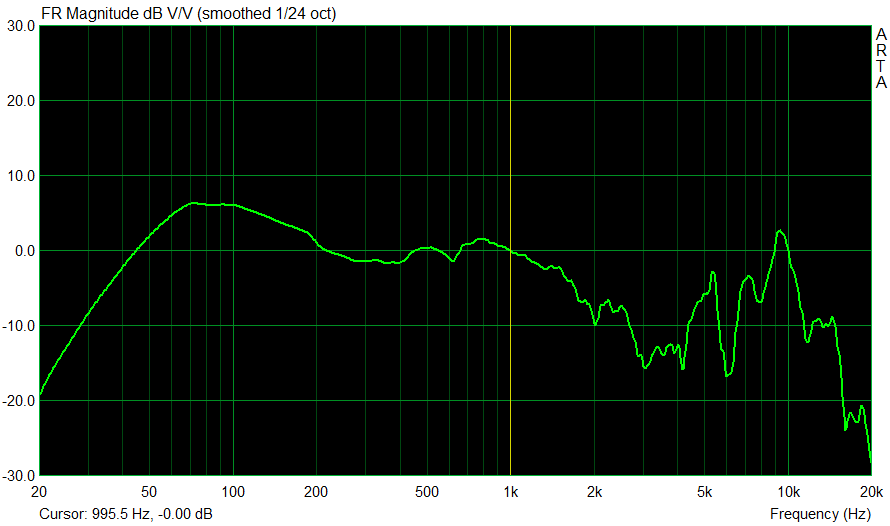
From the 20 Hz to 20 KHz according to the data sheet there is not much left, one would set the usual 3 dB as the tolerance limit. Here it is rather 20 dB, which is absolutely next to the track. with 30 Hz to 14 KHz at 6 dB I would still go along if I press both eyes firmly at the upper middle.
Cumulative Spectra (CSD and SFT)
The cumulative spectrum denotes different types of diagrams that show time-frequency properties of the signal. They are generated by successive application of the Fourier transformation and suitable windows to overlapping signal blocks. These analyses are based on the frequency response diagram already shown above, but also contain the element time and now show as a 3D graphic ("waterfall") very clearly how the frequency response develops over time after the input signal stopped. In colloquial terms, such a thing is also called "end" or "swingout".
Normally, the driver should also stop as fast as possible after the input signal has been dropped. However, some frequencies (or even entire frequency ranges) will always subside slowly and then continue to appear in this chart as longer-lasting frequencies on the timeline. This is a good way to see where the driver has glaring weaknesses, perhaps even "squealing" or where, in the worst case, resonances may occur and disturb the overall picture.
I will now test two types of cumulative spectrum:
Cumulative Spectral Decay (CSD)
Cumulative spectral decay (CSD) uses the FFT and a modified rectangular window to analyze the spectral drop of the pulse response. It is mainly used to analyze the speaker response. The CSD typically uses only a small FFT block shift (2-10 samples) to make resonances more visible throughout the frequency range, making it a useful tool for detecting the resonant of the converter.
The picture shows very nicely the bass resonances, whereby the level there shifts even depending on the frequency and it vibrates felt eternities. The result is a blurred and imprecise bass reproduction, in which even quite loud sounds come out of the headset when the signal has long since been silenced. It even takes almost endless 7 to 8 ms for the bass to be somewhat gone. This happens in a slightly different form just below seven kilohertz, where the driver is responsible.
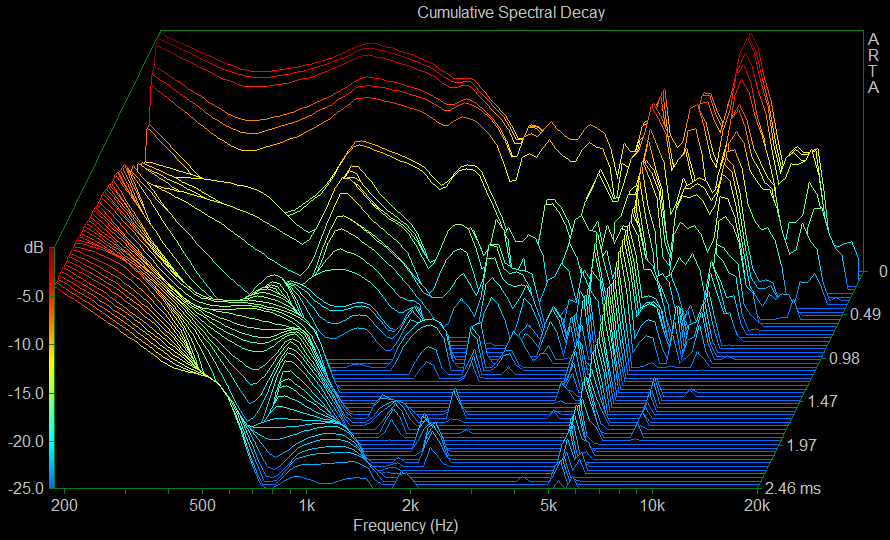
Short-time Fourier Transform (STF)
The Short-Time Fourier Transformation (STF) uses the FFT and Hanning windows to analyze the time-varying spectrum of recorded signals. In general, a larger block shift (1/4 to 1/2 of the FFT length) is used to analyze a larger part of the time-variable signal spectrum, whereby one gets closer to the fields of application such as language and music.
In the STF spectrum we now also see very nicely the work of the drivers, who unfortunately in some frequency ranges can afford some slight weakness. This "pulling" at some frequencies underlines the presumption that here the tweeter is also mechanically pushed by the driver, which I personally find rather a pity and exaggerated. I already write about the artificially inflated bass, especially since the decay curve directly at signal triggering in the area of the lower middles weakens extremely.
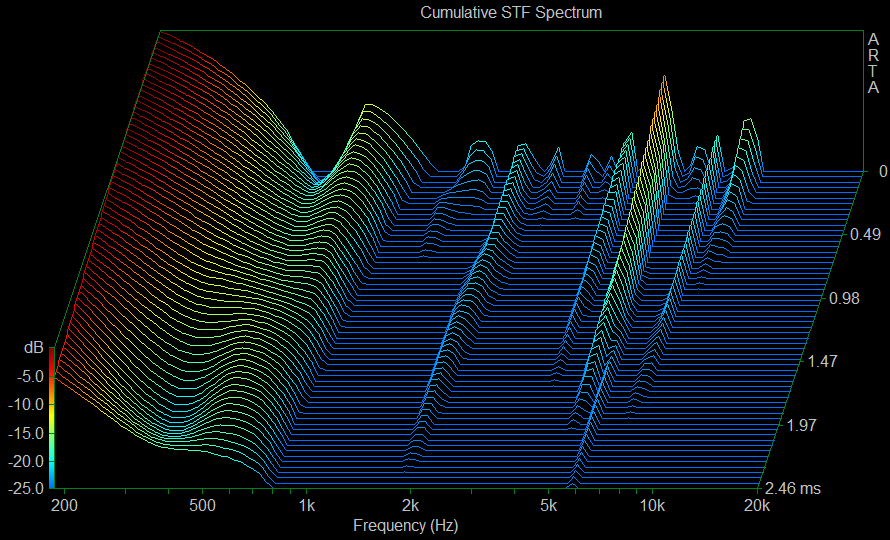
What remains as a summary is an indie behavior that still seems appropriate to the price range, but almost completely prevents any precision with a gesture of nonchalance. This is a real pity, but also in the subjective hearing test not to be discussed away. Because it's audible, even if you didn't see these curves at all.
Subjective listening experience
Now let's test subjectively what you get offered in the original without the offered sounding. However, as always, I locked the headset in the measuring room for almost 5 days beforehand and tormented it with a selected sound loop to scrub up operating hours. What not to do for our die-hard play fanatics among readers 🙂
Bass
Test the lowest bass in the subcontraoctave (16.4 Hz to 32.7 Hz) with a recording of Bach's Toccata and Fugue in D minor (19 and 25 Hz) and the Festival Overture 1812 by Tchaikovsky (10 Hz and 12.5 Hz). The same applies to the lower ranges of the contraoctothe (32.7 to 65.4 Hz). The big bass drum (kick drum), which in the U-music is a welcome companion and usually on approx. 55 to 60 Hz, this assessment will then be rounded off.
The original bass is rather weak, but present. However, the bass lives mainly from the very large-volume housing of the ear cups and therefore tends to imprecise rumbling. A dry kick becomes a whirlwith with a few milliseconds "reverberation" and with a bass guitar the sound is still standing after the next page has already been struck. You could certainly live quite well with some, rather trivial bass lines of common German rappers, but it's not for filigree sounds in the bass area, unfortunately. Dry is different and the punch is also missing. If the B1 is not one, then level-proof.
The upper bass up to 150 Hz, in which also the Great Octave (65.4 to 130.8 Hz) is located, houses the basic language frequency of the male voice and decides very strongly on the true-to-life reproduction of male vocals.
Male vowel looks a bit overwhelming and roaring, but anything but sovereign. This is a pity in that the basic frequency also decides on warmth and abundance and here already at the foundation the wading in the chocolate pudding becomes the main course. If you take the bass back a bit at 125 Hz, the area below it becomes a little more peaceful and level-proof and the membrane does not push senseless waves into the middle, which influence the midrange range so extremely.
Frequency range
The lower middles (also basic tone range) are approx. 150 to 400 Hz. Together with the already mentioned upper bass, this area plays a very important role for the subjectively perceived heat or bass. Fullness of the sound. The basic language frequency of female voices can be found in this area.
Female vocals sag in the beginning, which both decay diagrams above also illustrate very nicely. This area only gets back on the road after almost a millisecond, which leads to unsightly shifts when the sounds become more complex. Again, the equalizer helps a little if you dampen the lower frequency shares a little. Incidentally, it is also the frequency range that benefits most from the manual insertion of soft material into the capsule for damping.
The upper mids between 400 Hz and about two KHz contain a mark at a KHz, which is still considered a reference for many measurements. Unfortunately, this is often noticeable with cheaper devices, as manufacturers often try to overemphasize this frequency. This area does not play an insignificant role in gaming either, and balanced playback contributes significantly to good spatial resolution.
All this comes back to the ear with increasing frequency cleaner, clearer and also more differentiated. Even a depth graduation is audible at times, which then really surprised me positively. However, the upper middles go up on holiday. Up to two kilohertz the downward movement is like a steep toboggan run and even then it is not finished. Thus, the spatial location really suffers, especially the rather brighter sounds such as steps on concrete or space reverberation.
High-pitched range
Between two and about 3.5 KHz, human hearing is most sensitive, especially since this area of the lower heights is responsible for the good overtone reproduction of the human voice. This frequency range is crucial for the recognition of a voice or instrument; in this context, one also speaks of the respective timbre.
The downward trend continues, which deprives voices and many instruments of the individual timbre. All this becomes too uniform and interchangeable and the recognition factor of many soloists tends towards zero. This is most noticeable with mixed choirs and when the entire orchestra starts at the final chord. Then there is porridge without a real differentiation of the sources, a pity.
The middle heights (3.5 to six KHz) decide on the sound or failure of the speech reproduction as a whole, because the S- and hissing (Sibilants) fall into this range. The upper heights then reach up to approx. ten KHz to move into the super high tone.
The above-mentioned one even continues with a slight increase. This underlines the somewhat musty character, because there is no brilliance. Sibilants do not succeed concisely enough and so a susqué d'equine S quickly becomes an F. Type from approx. seven kilohertz everything gets a bit more bubbly, but it's too late. This then continues well over 12 KHz, except that the hot air in the super high tone does not reach down to warm up the sleepy cold feet in the bass foundation.
Summary and conclusion
 The manufacturer advertises that this headset was deliberately not included in the Skiller series, because it was not only available to gamers. All well and good, but to whom then? Certainly not to the music lover, who gets significantly better headphones in the same price range elsewhere. And a cardboard microphone, a la Zalman, which also sounds much more airy, is also available for as much as 4 euros. In the end, the headset is neither fish nor meat.
The manufacturer advertises that this headset was deliberately not included in the Skiller series, because it was not only available to gamers. All well and good, but to whom then? Certainly not to the music lover, who gets significantly better headphones in the same price range elsewhere. And a cardboard microphone, a la Zalman, which also sounds much more airy, is also available for as much as 4 euros. In the end, the headset is neither fish nor meat.
The Sharkoon B1 is too expensive for the newcomer, who could either live with the commandment because he has never screwed up his listening habits or has to take into account the financial constraints. For the price fox, which is priced for approx. 40 Euros already expected a little more, it is then too bad. If it were offered for 25 to 30 euros, I would take a much more benevolent view, because it simply is no longer possible. But so?
Sharkoon is known to offer low-cost products with maximum performance for the euro spent. But the B1 is not one of them and is therefore probably rather a grandiose slip. In the meantime, I have also telephoned the manufacturer and exchanged information about what I heard and what I measured. Here, too, there will certainly be a learning curve, because Sharkoon will also continue to try not to ruin the image with such pearls.
So what is left for me to conclude? If you like the shape, the sound seems acceptable and doesn't value brands: keep patience. I am quite sure that the price will continue to yield towards EUR 30. Then you can also buy without hesitation if you want or need to fish in this price range. Because that's where the Sharkoon B1 belongs. Everything else is optimism for purpose before the Lord.
Of course, I also have the right YouTube video for the reading lazy 🙂































Kommentieren